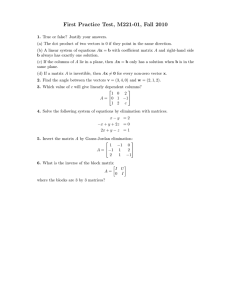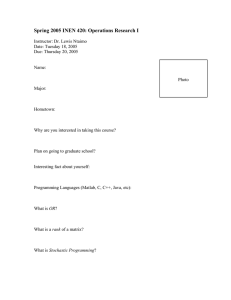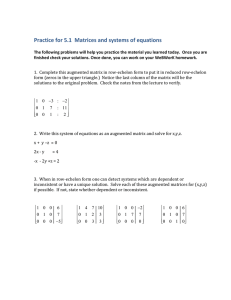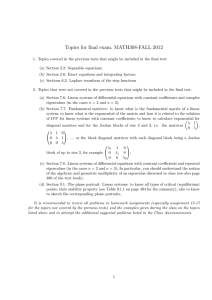SECTION 8.1 Matrix Solutions to Linear Systems
advertisement
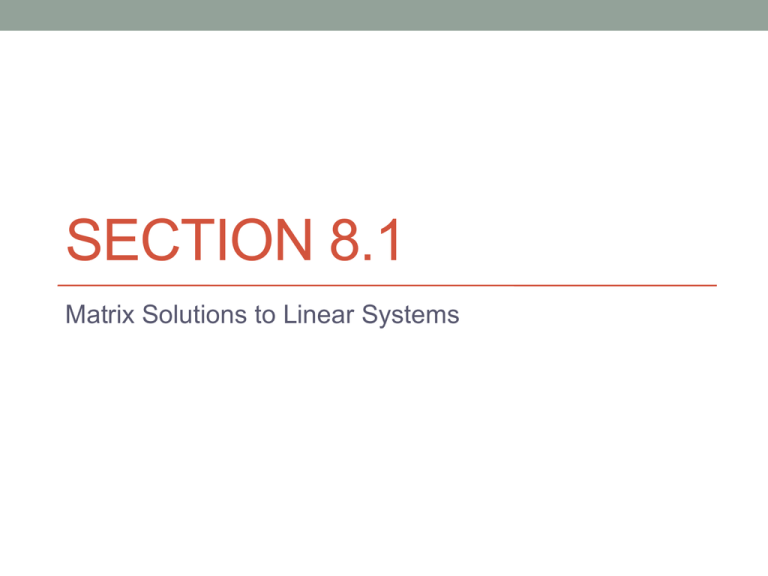
SECTION 8.1 Matrix Solutions to Linear Systems Graphing Inequalities • Ex: 𝑥 2 − 𝑦 2 > 16 • Our solution sets are typically regions of the Cartesian plane, not just points. • When graphing . . . Interpreting Inequality Signs ≥ ≤ Graph a solid curve > < Graph a dashed curve Systems of Inequalities • In order to solve a system of inequalities . . . 1. Graph the two inequalities. 2. Don’t forget to pay attention to “solid or dashed.” 3. Shade the region where they overlap. Matrices • Matrices are a valuable tool when used to solve systems of linear equations. • We can put linear equations into augmented matrices and perform row operations corresponding to the equation manipulations and combinations we have done in the past. Example 1 • Write the augmented matrix for the system of equations. 𝑥 − 𝑦 + 10𝑧 = 7 𝑦 − 4𝑧 = −5 𝑧=2 Example 2 • Write the augmented matrix for the system of equations. 2𝑤 − 2𝑥 + 4𝑦 + 𝑧 = 16 −2𝑥 + 𝑦 = −5 𝑤 + 𝑥 − 9𝑦 = −39 −9𝑤 − 8𝑥 + 2𝑦 = −39 Example 3 • Write the system of linear equations represented by the augmented matrix. Use 𝑥 , 𝑦, and 𝑧 for the variables. Matrices (cont.) • Rows in a matrix can be . . . 1. multiplied by a non-zero constant (represented 𝑘𝑅𝑖 ), 2. interchanged (represented 𝑅𝑖 ↔ 𝑅𝑗 ), and 3. added or subtracted (represented 𝑅𝑖 ± 𝑅𝑗 ). • Two matrices are row equivalent if one can be obtained from the other by a sequence of row operations. • A matrix with 1s down the diagonal and 0s below the 1s is said to be in row-echelon form. Think back . . . 𝑥 − 2𝑦 = 3 5𝑥 + 𝑦 = 4 Example 4 • Perform the indicated matrix row operation and write the new matrix. 3𝑅1 − 2𝑅2 Using Matrices to Solve Linear Systems • We can use matrices, applying Gaussian Elimination, to solve linear systems. Example 5 Solve the system using matrices. If there is no solution or if there are infinitely many solutions and a system’s equations are dependent, so state. 𝑥 + 𝑦 − 𝑧 = −2 2𝑥 − 𝑦 + 𝑧 = 5 −𝑥 + 2𝑦 + 2𝑧 = 1 Example 6 Solve the system using matrices. If there is no solution or if there are infinitely many solutions and a system’s equations are dependent, so state 𝑥 − 3𝑧 = −1 𝑥 + 5𝑦 − 𝑧 = −4 −3𝑥 + 6𝑦 + 2𝑧 = 11 Gauss-Jordan Elimination • Continues the process until there are 1s on the main diagonal and 0s below and above the main diagonal. • Such a matrix is said to be in reduced row-echelon form. • Either method can be applied to all of our problems. • We will just focus on Gaussian Elimination in this course. Example 7 Solve the system using Gaussian Elimination with backsubstitution or Gauss-Jordan Elimination. 3𝑥 + 𝑦 − 𝑧 = 0 2𝑥 + 3𝑦 − 5𝑧 = 1 𝑥 − 2𝑦 + 3𝑧 = −4 Example 8 The nutritional content per ounce of three foods is presented in the table on the right. If a meal consisting of the three foods allows exactly 2200 calories, 110 grams of protein, and 900 milligrams of vitamin C, how many ounces of each kind of food should be used? Calories Protein Vitamin C (in grams) (in milligrams) Food A 100 9 50 Food B 400 8 250 Food C 300 15 100
